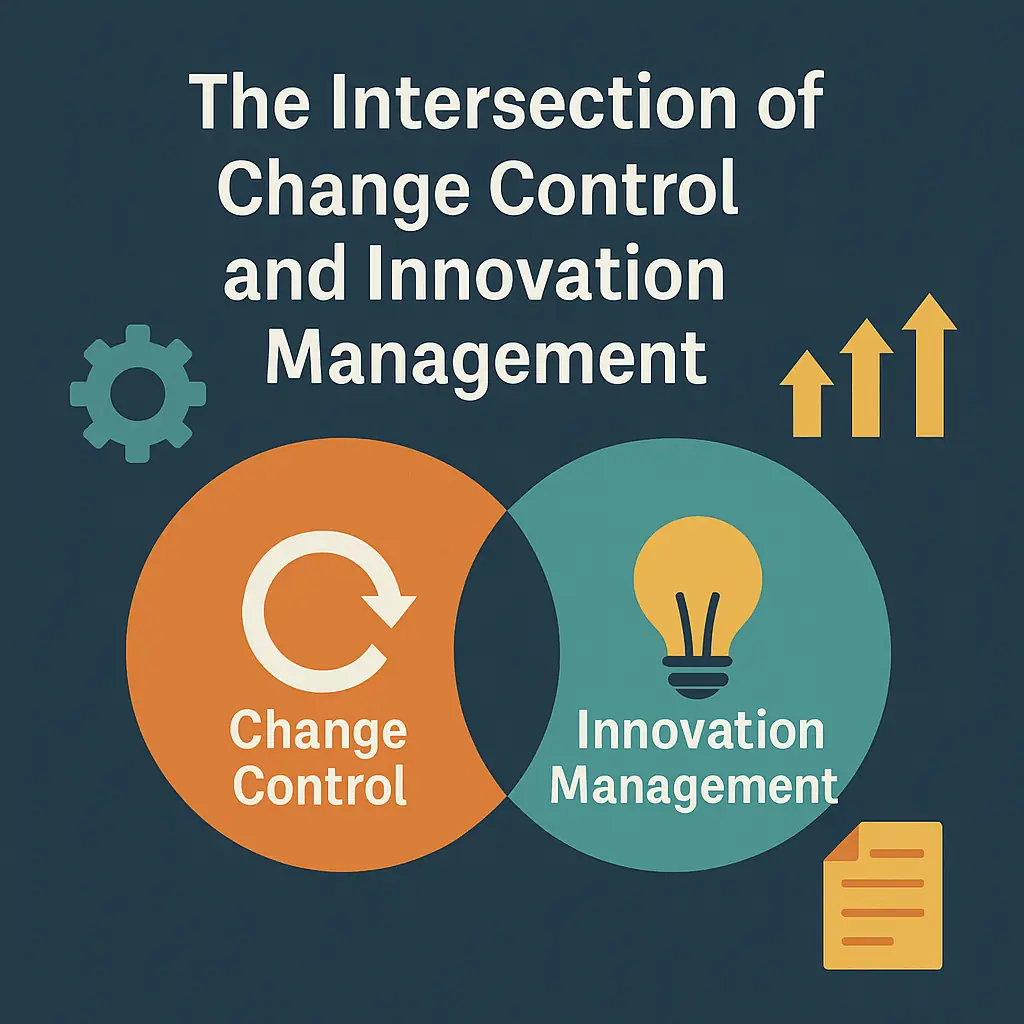Introduction
The change control process flow serves as a critical framework that governs how changes are proposed, evaluated, and implemented within a project. This structured approach ensures that any modifications to project scope, timelines, or resources are systematically assessed and managed, minimizing disruption while maximizing project success.
Change Control Process Flow Defined
The change control process flow typically involves several key stages: identification of the change, assessment of its impact, approval or rejection by relevant stakeholders, implementation of the change, and finally, documentation and communication of the change. This systematic approach not only helps in maintaining project integrity but also ensures that all team members are aligned and informed throughout the process.
Balancing Change Control with Innovation
While the change control process is essential for maintaining order and predictability in project management, it is equally important to recognize the need for innovation. In today’s fast-paced environment, project teams must be agile and responsive to new ideas and opportunities. Striking a balance between rigorous change control and the flexibility required for innovation is crucial. Effective change control can actually facilitate innovation by providing a clear framework within which creative ideas can be evaluated and integrated into ongoing projects. This balance allows teams to explore new solutions without losing sight of project objectives and constraints.
Audience and Context
This discussion is particularly relevant for innovation managers and project leaders who are tasked with navigating the complexities of project execution while fostering a culture of innovation. Understanding how to effectively implement change control processes can empower these leaders to harness innovative ideas, ensuring that their projects not only meet established goals but also adapt to emerging trends and technologies. By exploring the intersection of change control and innovation management, we can uncover strategies that enhance project outcomes and drive organizational success.
Understanding Change Control Process Flow
The change control process is a critical framework that ensures any modifications to a project are systematically evaluated and implemented. This process not only safeguards the project’s integrity but also fosters an environment conducive to innovation. Below, we outline the stages of the change control process, discuss common tools and techniques, and highlight the importance of documentation and communication.
Stages of the Change Control Process
- Identification: The first step involves recognizing the need for a change. This could stem from various sources, such as stakeholder feedback, project performance metrics, or external factors. Effective identification requires a keen understanding of project goals and the ability to foresee potential impacts of proposed changes.
- Evaluation: Once a change is identified, it must be thoroughly evaluated. This stage assesses the implications of the change on project scope, timeline, resources, and budget. Stakeholders should analyze both the benefits and risks associated with the change to make informed decisions.
- Approval: After evaluation, the proposed change must be approved by the relevant authorities, which may include project sponsors, steering committees, or change control boards. This step is crucial as it ensures that all changes align with the project’s strategic objectives and that there is consensus among key stakeholders.
- Implementation: Upon receiving approval, the change is implemented. This stage involves executing the change in a controlled manner, ensuring that all team members are aware of their roles and responsibilities. Effective implementation often requires training and support to facilitate a smooth transition.
- Closure: The final stage involves closing the change request. This includes documenting the change, assessing its impact, and ensuring that all stakeholders are informed of the outcomes. Closure is essential for maintaining a clear project history and for learning from the change process.
Common Tools and Techniques Used in Change Control
- Change Request Forms: Standardized forms help document the details of proposed changes, including the rationale, impact analysis, and approval status.
- Change Control Boards (CCBs): These groups are responsible for reviewing and approving change requests, ensuring that decisions are made collaboratively and transparently.
- Project Management Software: Tools like Microsoft Project, Trello, or Asana can facilitate tracking changes, managing tasks, and communicating updates among team members.
- Impact Analysis Tools: Techniques such as SWOT analysis (Strengths, Weaknesses, Opportunities, Threats) can help evaluate the potential effects of changes on the project.
The Role of Documentation and Communication
Effective documentation and communication are vital components of the change control process. They ensure that:
- Clarity and Transparency: All stakeholders have access to information regarding changes, which fosters trust and collaboration within the project team.
- Historical Record: Documenting changes provides a reference for future projects, helping teams learn from past experiences and avoid repeating mistakes.
- Stakeholder Engagement: Regular communication about changes keeps stakeholders informed and engaged, which is essential for maintaining support and alignment with project goals.
The Role of Change Control in Innovation Management
the intersection of change control and innovation management is crucial for fostering creativity while maintaining project integrity. Effective change control processes not only safeguard project objectives but also create an environment conducive to innovation. Here’s how structured change control can enhance creative problem-solving and minimize risks associated with innovation.
Structured Change Control and Creative Problem-Solving
- Framework for Innovation: A well-defined change control process provides a structured framework that encourages teams to explore new ideas while ensuring that any alterations align with project goals. This structure allows team members to propose innovative solutions without the fear of deviating from the project’s objectives. By establishing clear guidelines for evaluating and implementing changes, teams can focus on creative problem-solving without losing sight of the project’s overall vision.
- Encouraging Collaboration: Change control processes often involve cross-functional teams, which can lead to diverse perspectives and collaborative brainstorming. This collaborative environment is essential for innovation, as it allows team members to build on each other’s ideas and develop more comprehensive solutions. When team members feel empowered to share their insights within a structured process, it fosters a culture of innovation.
Minimizing Risks Associated with Innovation
- Risk Assessment and Management: A robust change control process includes thorough risk assessment protocols that help identify potential pitfalls associated with new ideas. By evaluating the implications of proposed changes, project leaders can make informed decisions that balance innovation with risk management. This proactive approach minimizes the likelihood of project derailment due to unforeseen consequences of innovative changes.
- Documentation and Traceability: Effective change control ensures that all changes are documented and tracked. This traceability is vital for understanding the impact of innovations on project timelines, budgets, and deliverables. By maintaining a clear record of changes, teams can analyze what worked and what didn’t, leading to continuous improvement in both the change control process and the innovation strategies employed.
Challenges of Implementing Change Control in Innovative Environments
Particularly within innovative environments, the change control process is often viewed with skepticism. While it is designed to ensure that changes are systematically evaluated and implemented, there are several challenges that can hinder its effectiveness and, paradoxically, stifle creativity. Below are key points that highlight these challenges:
Perception that Change Control Stifles Creativity
- Fear of Bureaucracy: Many team members perceive change control as a bureaucratic hurdle that slows down the creative process. This perception can lead to resistance against formal change procedures, as individuals may feel that their innovative ideas will be bogged down by excessive documentation and approval processes. This fear can create a culture where team members are hesitant to propose new ideas, fearing they will be dismissed or delayed due to change control protocols.
- Innovation vs. Regulation: In fast-paced, innovative environments, the need for agility is paramount. Change control processes, which often require thorough analysis and approval, can be seen as antithetical to the rapid iteration and experimentation that innovation demands. This dichotomy can lead to a conflict between the desire for creative freedom and the need for structured oversight.
Common Challenges Faced by Project Teams
- Inconsistent Application of Processes: Project teams often struggle with the inconsistent application of change control processes. In innovative projects, where the nature of work can be fluid and unpredictable, teams may find it challenging to adhere strictly to established protocols. This inconsistency can lead to confusion, miscommunication, and ultimately, project delays.
- Lack of Training and Understanding: Many project teams may not fully understand the change control process or its importance. Without proper training, team members may inadvertently bypass necessary steps, leading to poorly managed changes that can derail project objectives. This lack of understanding can foster a culture of non-compliance, where team members feel justified in ignoring change control measures in favor of expediency.
- Resource Constraints: Innovative projects often operate under tight deadlines and limited resources. Teams may prioritize immediate project needs over the rigorous application of change control processes, viewing them as an unnecessary burden. This prioritization can result in critical changes being implemented without proper evaluation, increasing the risk of project failure.
Strategies for Balancing Change Control and Innovation
The intersection of change control and innovation management is crucial for fostering a culture that embraces both stability and creativity. Effective change control processes can significantly enhance innovation within project teams by providing a structured approach to managing alterations while allowing for flexibility and responsiveness. Here are some actionable strategies for innovation managers and project leaders to integrate change control effectively:
1. Streamline Change Control Processes for Agility
- Simplify Approval Workflows: Reduce the number of approval layers in the change control process. By implementing a tiered approval system, minor changes can be expedited, allowing teams to respond quickly to new ideas and market demands. This agility can lead to faster implementation of innovative solutions.
- Utilize Technology: Leverage project management tools that facilitate real-time tracking and documentation of changes. Tools like Kanban boards or agile project management software can help visualize the change process, making it easier for teams to adapt and innovate without getting bogged down by bureaucratic procedures.
- Implement Change Control Templates: Create standardized templates for common types of changes. This can reduce the time spent on documentation and ensure that all necessary information is captured efficiently, allowing teams to focus more on innovation rather than administrative tasks.
2. Foster a Culture of Open Communication and Collaboration
- Encourage Feedback Loops: Establish regular check-ins and feedback sessions where team members can discuss potential changes and innovations. This open dialogue not only helps in identifying areas for improvement but also empowers team members to contribute their ideas, fostering a sense of ownership and collaboration.
- Cross-Functional Teams: Promote collaboration between different departments (e.g., marketing, development, and operations) to ensure diverse perspectives are considered during the change control process. This cross-pollination of ideas can lead to innovative solutions that might not emerge within siloed teams.
- Celebrate Successes and Learn from Failures: Create an environment where both successful innovations and failures are acknowledged. Celebrating successes reinforces the value of innovation, while analyzing failures can provide insights that improve future change control processes.
3. Recommend Training and Development Programs
- Workshops on Change Management: Organize training sessions that focus on the principles of change management and its importance in fostering innovation. These workshops can help team members understand how structured change control can support creative processes rather than hinder them.
- Innovation and Change Control Integration: Develop programs that specifically address the integration of innovation practices within change control frameworks. This could include case studies, role-playing scenarios, and hands-on exercises that illustrate how to balance the two effectively.
- Continuous Learning Opportunities: Encourage ongoing education through online courses, webinars, and industry conferences. Keeping teams updated on the latest trends in change management and innovation can inspire new ideas and approaches, ensuring that the organization remains competitive and forward-thinking.
By implementing these strategies, innovation managers and project leaders can create a balanced approach that not only maintains control over changes but also nurtures an environment ripe for innovation. This synergy between change control and innovation management is essential for driving project success and achieving organizational goals.
Measuring the Impact of Change Control on Innovation
The intersection of change control and innovation management is crucial for fostering a dynamic and responsive project environment. Effective change control processes not only mitigate risks but also create a fertile ground for innovation. To understand how change control can facilitate innovation, it is essential to establish metrics and key performance indicators (KPIs) that evaluate its effectiveness. Here are some key points to consider:
Key Performance Indicators for Measuring Innovation Success
- Rate of Successful Change Implementation: Measure the percentage of proposed changes that are successfully implemented without significant delays or issues. A high rate indicates an efficient change control process that supports innovation.
- Time to Market for New Ideas: Track the time taken from the initial idea generation to the implementation of changes. Shorter times suggest that the change control process is agile and conducive to innovation.
- Innovation Adoption Rate: Assess the percentage of new ideas or changes that are adopted by the team or organization. This metric reflects how well the change control process encourages the acceptance of innovative solutions.
- Stakeholder Satisfaction: Use surveys to gauge the satisfaction of stakeholders with the change control process. High satisfaction levels can indicate that the process is perceived as supportive of innovation.
- Return on Investment (ROI) for Innovations: Calculate the financial benefits derived from innovations implemented through the change control process. A positive ROI demonstrates the value of effective change management in fostering innovation.
Assessing the Efficiency of Change Control Processes
To evaluate the efficiency of change control processes, consider the following methods:
- Process Cycle Time Analysis: Measure the time taken for each stage of the change control process, from initiation to approval and implementation. Identifying bottlenecks can help streamline processes and enhance responsiveness to innovative ideas.
- Change Request Volume: Analyze the number of change requests submitted over a specific period. A high volume may indicate a need for better initial planning or a more flexible change control process that can accommodate innovation.
- Compliance with Change Control Procedures: Monitor adherence to established change control procedures. High compliance rates suggest that the process is well understood and integrated into the team’s workflow, which can facilitate innovation.
Gathering Feedback from Teams on the Impact of Change Control
Feedback from project teams is invaluable in assessing the impact of change control on innovation efforts. Here are some effective methods for gathering this feedback:
- Regular Team Surveys: Conduct surveys to collect insights on how team members perceive the change control process. Questions can focus on perceived barriers to innovation, the clarity of procedures, and overall satisfaction with the process.
- Focus Groups: Organize focus group discussions with team members to delve deeper into their experiences with change control. This qualitative feedback can provide rich insights into how the process affects their ability to innovate.
- Post-Implementation Reviews: After implementing significant changes, hold review sessions to discuss what worked well and what could be improved. This retrospective analysis can highlight the strengths and weaknesses of the change control process in relation to innovation.
- Innovation Metrics Dashboard: Create a dashboard that tracks innovation-related metrics alongside change control metrics. This visual representation can help teams see the direct impact of change control on their innovation efforts and encourage ongoing dialogue about improvements.
By establishing clear KPIs, assessing the efficiency of change control processes, and actively gathering feedback from teams, project leaders and innovation managers can create a robust framework that not only manages change effectively but also nurtures a culture of innovation. This approach ensures that change control becomes a catalyst for creativity and progress within project teams.
Conclusion
In the dynamic landscape of project management, the intersection of change control and innovation management is crucial for fostering a culture of creativity and adaptability. Throughout this discussion, we have explored several key points that highlight the importance of integrating effective change control processes within project teams to facilitate innovation.
- Change Control as a Catalyst for Innovation: We established that a well-structured change control process does not merely serve as a bureaucratic hurdle; rather, it acts as a catalyst that enables teams to embrace new ideas and adapt to evolving project requirements. By providing a clear framework for evaluating and implementing changes, project teams can respond swiftly to innovative opportunities without compromising project integrity.
- Enhancing Collaboration and Communication: Effective change control fosters an environment of open communication and collaboration among team members. This transparency allows for diverse perspectives to be considered, leading to more innovative solutions. When team members feel empowered to propose changes, they are more likely to contribute creatively, knowing that their ideas will be evaluated fairly and systematically.
- Risk Management and Innovation: We discussed how integrating change control with innovation management helps in identifying potential risks associated with new ideas early in the process. By assessing these risks through a structured change control framework, project leaders can make informed decisions that balance innovation with project stability, ultimately leading to successful outcomes.
- Continuous Improvement: Finally, we emphasized the role of change control in promoting a culture of continuous improvement. By regularly reviewing and refining change processes, organizations can enhance their ability to innovate, ensuring that they remain competitive in a rapidly changing market.
As innovation managers and project leaders, it is essential to view change control not as an obstacle but as a facilitator of innovation. By embracing this perspective, you can create an environment where creativity thrives, and your teams are empowered to explore new possibilities.
Find out more about Shaun Stoltz https://www.shaunstoltz.com/about/.
This post was written by an AI and reviewed/edited by a human.



